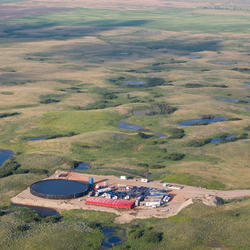Sublethal Effects
Sublethal Effects
Filter Total Items: 22
Behavioral Toxicology Core Technology Team
About the Research. The Environmental Health Program supports scientists in the Behavioral Toxicology Core Technology Team (CTT) at the Columbia Environmental Research Center. The scientists identify how contaminants alter the behavior of organisms and what implication those changes may have on individuals, populations, and communities.
Per-and Polyfluoroalkyl Substances (PFAS) Integrated Science Team
Increasing scientific and public awareness of the widespread distribution of per- and poly-fluoroalkyl substances (PFAS) in U.S. drinking-water supplies, aquatic and terrestrial ecosystems, wildlife, and humans has raised many public health and resource management questions that U.S. Geological Survey's (USGS) science can inform. The USGS Environmental Health Program's PFAS Integrated Science Team...
PFAS Transport, Exposure, and Effects
The team is determining the movement and behavior of per- and poly-fluoroalkyl substances (PFAS) from their sources in the environment, as they move through exposure pathways in ecosystems including watersheds and aquifers, their incorporation into food webs, and molecular to population scale effects on fish and wildlife. These studies are accomplished at a variety of spatial scales from regional...
Toxins and Harmful Algal Blooms Science Team
The team develops advanced methods to study factors driving algal toxin production, how and where wildlife or humans are exposed to toxins, and ecotoxicology. That information is used to develop decision tools to understand if toxin exposure leads to adverse health effects in order to protect human and wildlife health.
Ecologically-Driven Exposure Pathways Science Team
The Ecologically-Driven Exposure Pathways Integrated Science Team identifies how ecological pathways and physiological processes within a single organism can alter exposure and toxicity of contaminants and pathogens and seek to understand outcomes at different scales from individuals to populations and ecosystems.
Scientists Provide an Understanding of Anticoagulant Rodenticide Exposure in Non-Target Bird Species
U.S. Geological Survey scientists and their partners utilize laboratory and field studies and existing information to improve understanding of anticoagulant rodenticide exposure and effects to wild birds.
Advanced PFAS Measurement Methods
Environmental Health Program scientists, in collaboration with other USGS scientists, are developing complementary field and laboratory methods and capabilities to detect and quantify a range of target and nontarget per- and polyfluoroalkyl substances (PFAS) and indicator compounds at low levels (parts per trillion) in a variety of environmental matrices. The PFAS Integrated Science Team is...
Energy Integrated Science Team
The Energy Lifecycle Integrated Science Team focuses on the potential for contaminant exposures in the environment that might originate from energy resource activities including, extraction, production, transportation, storage, extraction, waste management and restoration. Perceived health risks to humans and other organisms will be distinguished from actual risks, if any. If actual risks are...
Bird Hatchling Development Following Exposure to Environmentally Relevant Levels of Brominated Flame Retardants
Scientists performed laboratory studies with American kestrels and zebra finch to determine the effects of brominated flame retardant exposure on hatchlings. They found evidence that exposure while in the egg disrupted thyroid function in female American kestrel hatchlings and affected nestling body condition in zebra finch hatchlings, but no other effects were detected.
Intersex in Male Smallmouth Bass in the Missisquoi River in Vermont: Understanding Factors that Can Lead to Endocrine Disruption in Field Settings
The presence of testicular oocytes (intersex) in male smallmouth bass ( Micropterus dolomieu ) in the Missisquoi River in Vermont varied over the period of the study and was not related to concentrations of known endocrine disrupting chemicals in the River. Although previous studies have shown linkages between endocrine disrupting chemical exposures and intersex in fish, these results indicate...
Sublethal Effects of Contaminants in Aquatic Food Webs—Research Challenges and Considerations for Future Studies
U.S. Geological Survey (USGS) and academic scientists partnered to identify challenges and provide considerations for future scientific study designs to advance our understanding of the often subtle sublethal effects of contaminants on individuals, populations, communities, and entire aquatic food webs.
Can There be Unintended Benefits when Wastewater Treatment Infrastructure is Upgraded?
Science from the U.S. Geological Survey (USGS) and other entities has shown that a mixture of natural and synthetic estrogens and other similar chemicals are discharged from wastewater treatment plants (WWTPs) to streams and rivers.













